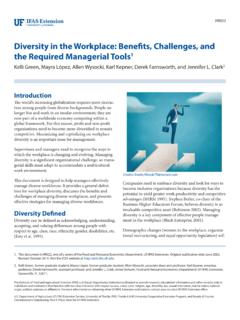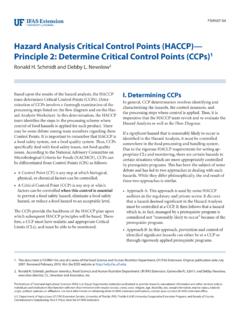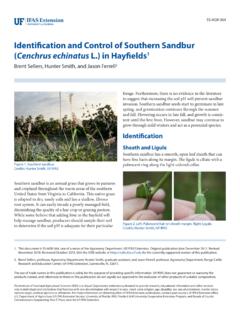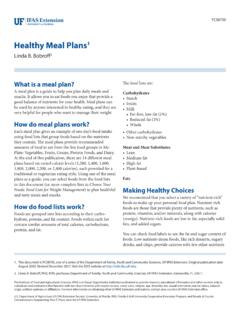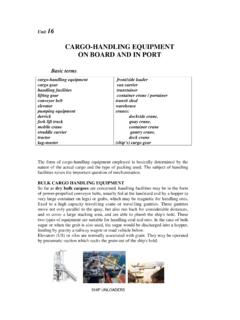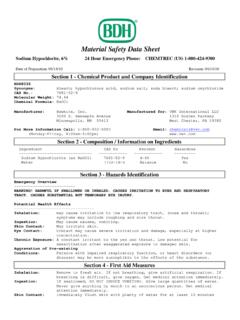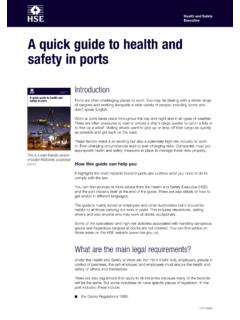Transcription of Basic Elements of Equipment Cleaning and Sanitizing in ...
1 FS14 Basic Elements of Equipment Cleaning and Sanitizing in Food Processing and handling Operations1 Ronald H. Schmidt21. This document is FS14, one of a series of the Food Science and Human Nutrition Department, UF/IFAS Extension. Original publication date July 1997. Revised March 2009. Reviewed November 2018. Visit the EDIS website at for the currently supported version of this Ronald H. Schmidt, Ph. D., professor and food science Extension specialist, Food Science and Human Nutrition Department; UF/IFAS Extension, Gainesville, FL Institute of Food and Agricultural Sciences (IFAS) is an Equal Opportunity Institution authorized to provide research, educational information and other services only to individuals and institutions that function with non-discrimination with respect to race, creed, color, religion, age, disability, sex, sexual orientation, marital status, national origin, political opinions or affiliations.
2 For more information on obtaining other UF/IFAS Extension publications, contact your county s UF/IFAS Extension Department of Agriculture, UF/IFAS Extension Service, University of Florida, IFAS, Florida A & M University Cooperative Extension Program, and Boards of County Commissioners Cooperating. Nick T. Place, dean for UF/IFAS document explains the details of Equipment Cleaning and Sanitizing procedures in food-processing and/or food- handling and Sanitizing ProgramSince Cleaning and Sanitizing may be the most important aspects of a sanitation program, sufficient time should be given to outline proper procedures and parameters. De-tailed procedures must be developed for all food-product contact surfaces ( Equipment , utensils, etc.) as well as for non-product surfaces such as non-product portions of Equipment , overhead structures, shields, walls, ceilings, lighting devices, refrigeration units and heating, ventilation and air conditioning (HVAC) systems, and anything else which could impact food frequency must be clearly defined for each process line ( , daily, after production runs, or more often if necessary).
3 The type of Cleaning required must also be objective of Cleaning and Sanitizing food contact surfaces is to remove food (nutrients) that bacteria need to grow, and to kill those bacteria that are present. It is impor-tant that the clean, sanitized Equipment and surfaces drain dry and are stored dry so as to prevent bacteria growth. Necessary Equipment (brushes, etc.) must also be clean and stored in a clean, sanitary procedures must be evaluated for adequacy through evaluation and inspection procedures. Adherence to prescribed written procedures (inspection, swab testing, direct observation of personnel) should be continuously monitored, and records maintained to evalu-ate long-term correct order of events for Cleaning / Sanitizing of food product contact surfaces is as follows:1. Rinse2. Clean3. Rinse4. is the complete removal of food soil using appro-priate detergent chemicals under recommended conditions.
4 It is important that personnel involved have a working Reviewed: 08/20212 Basic Elements of Equipment Cleaning and Sanitizing in Food Processing and handling Operationsunderstanding of the nature of the different types of food soil and the chemistry of its MethodsEquipment can be categorized with regard to Cleaning method as follows: Mechanical Cleaning . Often referred to as clean-in-place (CIP). Requires no disassembly or partial disassembly. Clean-out-of-Place (COP). Can be partially disassembled and cleaned in specialized COP pressure tanks. Manual Cleaning . Requires total disassembly for Cleaning and is important to differentiate and define certain terminology: Sterilize refers to the statistical destruction and removal of all living organisms. Disinfect refers to inanimate objects and the destruction of all vegetative cells (not spores). Sanitize refers to the reduction of microorganisms to levels considered safe from a public health and approved sanitization procedures are processes, and, thus, the duration or time as well as the chemical conditions must be described.
5 The official definition (Association of Official Analytical Chemists) of Sanitizing for food product contact surfaces is a process which reduces the contamination level by (5 logs) in 30 official definition for non-product contact surfaces requires a contamination reduction of (3 logs). The standard test organisms used are Staphylococcus aureus and Escherichia types of sanitization include the following: Thermal Sanitization involves the use of hot water or steam for a specified temperature and contact time. Chemical Sanitization involves the use of an approved chemical sanitizer at a specified concentration and contact Chemistry and QualityWater comprises approximately 95% 99% of Cleaning and Sanitizing solutions. Water functions to do the following: carry the detergent or the sanitizer to the surface carry soils or contamination from the impurities in water can drastically alter the effective-ness of a detergent or a sanitizer.
6 Water hardness is the most important chemical property with a direct effect on Cleaning and Sanitizing efficiency. (Other impurities can affect the food contact surface or may affect the soil deposit properties or film formation.)Water pH ranges generally from pH 5 to This range is of no serious consequence to most detergents and sanitiz-ers. However, highly alkaline or highly acidic water may require additional buffering can also contain significant numbers of microorgan-isms. Water used for Cleaning and Sanitizing must be potable and pathogen-free. Treatments and sanitization of water may be required prior to use in Cleaning regimes. Water impurities that affect Cleaning functions are pre-sented in Table OF FOOD SOILSFood soil is generally defined as unwanted matter on food-contact surfaces. Soil is visible or invisible. The primary source of soil is from the food product being handled.
7 However, minerals from water residue and residues from Cleaning compounds contribute to films left on surfaces. Microbiological biofilms also contribute to the soil buildup on soils vary widely in composition, no one detergent is capable of removing all types. Many complex films contain combinations of food components, surface oil or dust, insoluble cleaner components, and insoluble hard-water salts. These films vary in their solubility properties depend-ing upon such factors as heat effect, age, dryness, time, is essential that personnel involved have an understand-ing of the nature of the soil to be removed before selecting a detergent or Cleaning regime. The rule of thumb is that acid cleaners dissolve alkaline soils (minerals) and alkaline cleaners dissolve acid soils and food wastes. Improper use of detergents can actually set soils, making them more dif-ficult to remove ( , acid cleaners can precipitate protein).
8 Many films and biofilms require more sophisticated 3 Basic Elements of Equipment Cleaning and Sanitizing in Food Processing and handling Operationscleaners that are amended with oxidizing agents (such as chlorinated detergents) for may be classified as the following: soluble in water (sugars, some starches, most salts); soluble in acid (limestone and most mineral deposits); soluble in alkali (protein, fat emulsions); soluble in water, alkali, or physical condition of the soil deposits also affects its solubility. Freshly precipitated soil in a cool or cold solution is usually more easily dissolved than an old, dried, or baked-on deposit, or a complex film. Food soils are com-plex in that they contain mixtures of several components. A general soil classification and removal characteristics are presented in Table SoilsFat usually is present as an emulsion and can generally be rinsed away with hot water above the melting point.
9 More difficult fat and oil residues can be removed with alkaline detergents, which have good emulsifying or saponifying SoilsIn the food industry, proteins are by far the most difficult soils to remove. In fact, casein (a major milk protein) is used for its adhesive properties in many glues and paints. Food proteins range from more simple proteins, which are easy to remove, to more complex proteins, which are very difficult to remove. Heat-denatured proteins can be extremely , a highly alkaline detergent with peptizing or dissolving properties is required to remove protein soils. Wetting agents can also be used to increase the wettability and suspendability of proteins. Protein films require alkaline cleaners that have hypochlorite in addition to wetting SoilsSimple sugars are readily soluble in warm water and are quite easily removed. Starch residues, individually, are also easily removed with mild detergents.
10 Starches associated with proteins or fat scan usually be easily removed by highly alkaline Salt-Based SoilsMineral salts can be either relatively easy to remove or be highly troublesome deposits or films. Calcium and magnesium are involved in some of the most difficult mineral films. Under conditions involving heat and alkaline pH, calcium and magnesium can combine with bicarbonates to form highly insoluble complexes. Other difficult deposits contain iron or manganese. Salt films can also cause corrosion of some surfaces. Difficult salt films require an acid cleaner (especially organic acids that form complexes with these salts) for removal. Sequestering agents such as phosphates or chelating agents are often used in detergents for salt film FilmsUnder certain conditions, microorgranisms (bacteria, yeasts, and molds) can form invisible films (biofilms) on surfaces. Biofilms can be difficult to remove and usually require cleaners as well as sanitizers with strong oxidizing Greases and OilsThese deposits (insoluble in water, alkali, or acid) can often be melted with hot water or steam, but often leave a residue.

